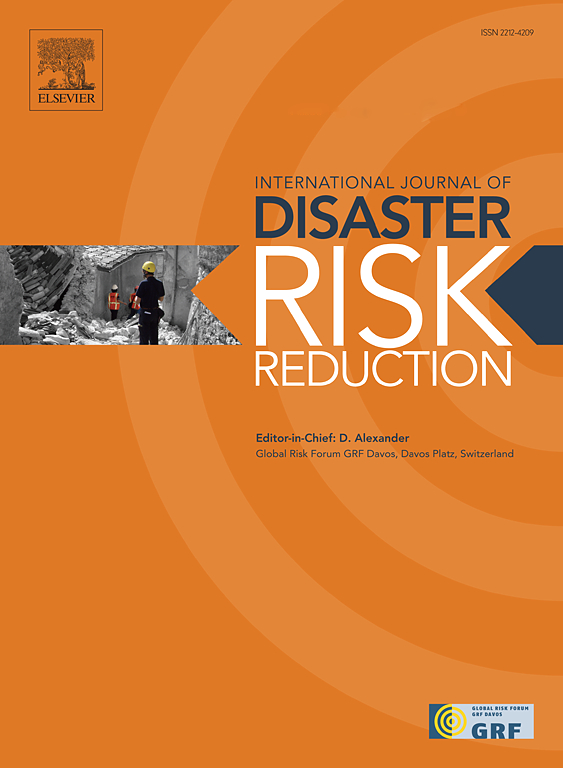自动地震易损性和建筑物易损性评估(ASFRAVA-B):将概率地震设计集成到基于性能的工程实践中
IF 4.5
1区 地球科学
Q1 GEOSCIENCES, MULTIDISCIPLINARY
International journal of disaster risk reduction
Pub Date : 2025-07-02
DOI:10.1016/j.ijdrr.2025.105679
引用次数: 0
摘要
地震易损性和脆弱性的实际评估对于有效的地震工程和减轻风险至关重要。本研究介绍了ASFRAVA-B,这是一个开源的自动化框架,旨在为建筑物评估导出地震易损性和脆弱性函数。ASFRAVA-B采用容量谱法和内置统计程序,有效生成地震易损性和易损性曲线。该框架支持各种统计拟合方法,包括具有最大似然估计的多条纹分析,具有logit和probit链接的广义线性模型,以及具有三种正则化选项的机器学习逻辑回归。它为用户选择脆弱性功能提供了灵活性。通过两个案例研究证明了ASFRAVA-B的适用性:(1)与开放式框架相比,砌体填充物如何影响两层学校建筑的地震易损性和脆弱性;(2)采用增量动力分析对四层三维多自由度建筑模型进行非线性时程分析(NLTHA)对比。结果表明,尽管在推覆曲线上表现出更大的刚度和强度,但填充框架总体上比开放框架表现出更高的超越概率。这一结果强调了在结构模型中考虑砌体填充墙的必要性,特别是对于低层结构,这种填充对整体刚度有显著贡献。在对比分析中,ASFRAVA-B倾向于略微高估较低强度下的损伤概率,但与详细的NLTHA模型相比,它提供了可观的计算效率。敏感性分析表明,地震动记录的配置对易碎性曲线的影响不大,强调了谨慎选择记录对可靠结果的重要性。本文章由计算机程序翻译,如有差异,请以英文原文为准。
Automated Seismic Fragility and Vulnerability Assessment for Buildings (ASFRAVA-B): Integrating probabilistic seismic design into performance-based engineering practices
Practical assessment of seismic fragility and vulnerability is critical for effective earthquake engineering and risk mitigation. This study introduces ASFRAVA-B, an open-source, automated framework designed to derive seismic fragility and vulnerability functions for building assessments. ASFRAVA-B employs the capacity spectrum method and built-in statistical procedures to efficiently generate seismic fragility and vulnerability curves. The framework supports various statistical fitting methods, including multiple stripes analysis with maximum likelihood estimation, generalized linear models with logit and probit links, and machine-learning logistic regression, with three regularization options. It offers flexibility for users to choose the fragility function. The applicability of ASFRAVA-B is demonstrated through two case studies: (1) an evaluation of how masonry infill affects the seismic fragility and vulnerability of a two-story school building compared to an open frame; and (2) a comparative exercise against Nonlinear Time History Analysis (NLTHA) of a four-story, three-dimensional multiple-degree-of-freedom building model using incremental dynamic analysis. Results show that the infilled frame generally exhibits a higher probability of exceedance than the open frame, despite demonstrating greater stiffness and strength in the pushover curve. This result highlights the necessity of considering masonry infill walls in structural models, particularly for low-rise structures where such infill significantly contributes to overall stiffness. In the comparative analysis, ASFRAVA-B tends to slightly overestimate damage probabilities at lower intensity measures, yet provides substantial computational efficiency compared to the detailed NLTHA model. Sensitivity analyses demonstrate that the configuration of ground motion records exerts a moderate influence on fragility curves, emphasizing the importance of careful record selection for reliable outcomes.
求助全文
通过发布文献求助,成功后即可免费获取论文全文。
去求助
来源期刊

International journal of disaster risk reduction
GEOSCIENCES, MULTIDISCIPLINARYMETEOROLOGY-METEOROLOGY & ATMOSPHERIC SCIENCES
CiteScore
8.70
自引率
18.00%
发文量
688
审稿时长
79 days
期刊介绍:
The International Journal of Disaster Risk Reduction (IJDRR) is the journal for researchers, policymakers and practitioners across diverse disciplines: earth sciences and their implications; environmental sciences; engineering; urban studies; geography; and the social sciences. IJDRR publishes fundamental and applied research, critical reviews, policy papers and case studies with a particular focus on multi-disciplinary research that aims to reduce the impact of natural, technological, social and intentional disasters. IJDRR stimulates exchange of ideas and knowledge transfer on disaster research, mitigation, adaptation, prevention and risk reduction at all geographical scales: local, national and international.
Key topics:-
-multifaceted disaster and cascading disasters
-the development of disaster risk reduction strategies and techniques
-discussion and development of effective warning and educational systems for risk management at all levels
-disasters associated with climate change
-vulnerability analysis and vulnerability trends
-emerging risks
-resilience against disasters.
The journal particularly encourages papers that approach risk from a multi-disciplinary perspective.
 求助内容:
求助内容: 应助结果提醒方式:
应助结果提醒方式:


